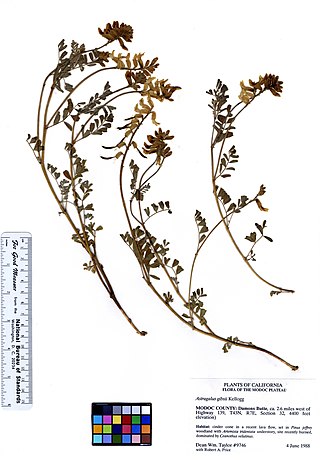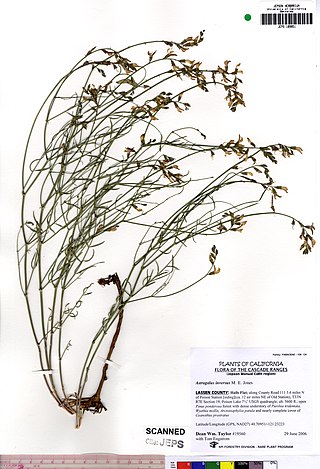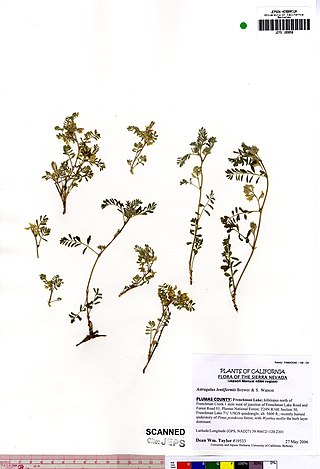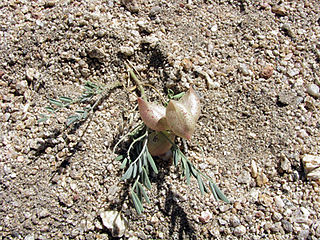
Astragalus albens is a species of milkvetch known by the common names Cushenbury milkvetch and silvery-white milkvetch.
Astragalus austiniae is a species of milkvetch known by the common name Austin's milkvetch. It is native to the Sierra Nevada of California and Nevada in the vicinity of Lake Tahoe. It is a plant of the alpine climate of the high mountains, where it tolerates exposed areas.

Astragalus bicristatus is a species of milkvetch known by the common names crested milkvetch and two-crested milkvetch. It is endemic to southern California, where it grows in the coniferous forests of the San Gabriel and San Bernardino Mountains of the Transverse Ranges.

Astragalus bolanderi is a species of milkvetch known by the common name Bolander's milkvetch. It is native to western Nevada and parts of the Sierra Nevada in California. It grows in dry, rocky habitat on mountain and plateau.

Astragalus congdonii is a species of milkvetch known by the common name Congdon's milkvetch. It is a perennial herb that is endemic to central California.
Astragalus deanei is a rare species of milkvetch known by the common name Dean's milkvetch, or Deane's milkvetch. It is endemic to southern San Diego County, California, where it grows on the slopes of the Peninsular Ranges between El Cajon and Tecate.

Astragalus gibbsii is a species of milkvetch known by the common name Gibbs's milkvetch. It is native to eastern California, the north-central Sierra Nevada, and western Nevada, where it grows in the pine forest habitat of the mountains and the sagebrush of the plateaus.
Astragalus gilmanii is a species of milkvetch known by the common name Gilman's milkvetch. It is native to the desert scrub and woodland of Nevada, the California Sierra Nevada and Inyo Mountains, and it is known from a few locations in the Panamint Range adjacent to Death Valley in California.

Astragalus inversus is a species of milkvetch known by the common name Susanville milkvetch.

Astragalus kentrophyta is a species of milkvetch known by the common name spiny milkvetch. It is native to western North America from central to west Canada, to California, to New Mexico. It grows in rocky mountainous areas, such as the Sierra Nevada, and on plateaus.

Astragalus lentiformis is a species of milkvetch known by the common name lens-pod milkvetch. It is endemic to the Sierra Nevada in eastern Plumas County, California, where it grows in chaparral scrub and coniferous forests.
Astragalus miguelensis is a rare species of milkvetch known by the common name San Miguel milkvetch. It is endemic to five of the eight Channel Islands of California.

Astragalus nutans is a species of milkvetch known by the common name Providence Mountains milkvetch.
Astragalus oocarpus is a rare species of milkvetch known by the common names San Diego milkvetch and Descanso milkvetch.

Astragalus oxyphysus is a species of milkvetch known by the common name Diablo milkvetch. It is endemic to central California, where it grows in dry grassland and scrub habitat in the Central Valley and the adjacent Inner Coast Ranges and Sierra Nevada foothills.
Astragalus panamintensis is a species of milkvetch known by the common name Panamint milkvetch.

Astragalus shevockii is a rare species of milkvetch known by the common names Little Kern milkvetch and Shevock's milkvetch. It is endemic to Tulare County, California, where it grows in the High Sierra, generally on granite-based soils in Jeffrey pine forests.
Astragalus subvestitus is a species of milkvetch known by the common name Kern County milkvetch.
Astragalus traskiae is a rare species of milkvetch known by the common name Trask's milkvetch. It is endemic to the southern Channel Islands of California, where it is known only from Santa Barbara Island and San Nicolas Island.

Astragalus desereticus is a rare species of milkvetch known by the common name Deseret milkvetch. It is endemic to Utah County, Utah, where it is known from only one population. It was thought to be extinct until 1981 when this population was discovered. The population contains 5,000 to 10,000 plants on an area of land covering less than 300 acres. It is vulnerable to damage from grazing cattle, which eat the plant and trample the soil, and from development and erosion. This is a federally listed threatened species.













